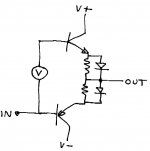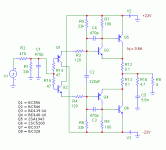This is puzzling. I first had a look at the swedish patent office
www.prv.se but I couldn't find any way to search for patents or
applications there (and it is not because of any language
problems in my case, I assure you 🙂 ). I then used the
link Steve gave. If selecting Sweden I only got errors when
trying to search (could be some temporary server problem
maybe). I also tried searching the whole of Europe, which I
assume is the applications database at the european patent
office. Trying both the company Tunerlux and the person Hazelius
and both as applicant and inventor gave nothing. More puzzling
is that I can't even reach the company website www.tunerlux.com
Once again, this could be temporary, but the whole things is
a little bit misty.
The patent could be filed under the name of some other person
working at(owning Tunerlux, of course, and that is why I tried
to reach their own homepage, to hunt for names.
www.prv.se but I couldn't find any way to search for patents or
applications there (and it is not because of any language
problems in my case, I assure you 🙂 ). I then used the
link Steve gave. If selecting Sweden I only got errors when
trying to search (could be some temporary server problem
maybe). I also tried searching the whole of Europe, which I
assume is the applications database at the european patent
office. Trying both the company Tunerlux and the person Hazelius
and both as applicant and inventor gave nothing. More puzzling
is that I can't even reach the company website www.tunerlux.com
Once again, this could be temporary, but the whole things is
a little bit misty.
The patent could be filed under the name of some other person
working at(owning Tunerlux, of course, and that is why I tried
to reach their own homepage, to hunt for names.
I'm not at all concerned.
😎
More info, since you ask.
TunerLux AB
Ekebybruk A1
S-752 75 Uppsala
Sweden
Tel +46 18 55 88 32
Fax +46 18 55 88 31
"protected by a PCT application: PCT/SE99/02050.
Patents granted in the Unites State, the European
Community and Japan."
😎
More info, since you ask.
TunerLux AB
Ekebybruk A1
S-752 75 Uppsala
Sweden
Tel +46 18 55 88 32
Fax +46 18 55 88 31
"protected by a PCT application: PCT/SE99/02050.
Patents granted in the Unites State, the European
Community and Japan."
Oh, I am not very concerned myself, but since other people
seemed eager to dig up the patent without success, I thought
I would try to help them and see if it was any easier to find it
from the swedish side. Well, as reported, that didn't help. 🙁
I suppose you received the patent nr with the mail, Nelson?
seemed eager to dig up the patent without success, I thought
I would try to help them and see if it was any easier to find it
from the swedish side. Well, as reported, that didn't help. 🙁
I suppose you received the patent nr with the mail, Nelson?
No, I didn't, although its operation is described clearly.
I'll have to open a bottle of Cabernet and think about
what it might bring to the table, hype aside.
I'll have to open a bottle of Cabernet and think about
what it might bring to the table, hype aside.
And I wonder if they're aware that "Crystal Sound System" is already being used by Philips for a technology they use in their cellular phones to improve sound quality?
Not to mention Crystal Semiconductor(now part of Intel) often uses the term "Crystal Sound System" when describing their PC audio sound chipsets.
Intel?
moses, don't you mean Cirrus Logic? I wasn't aware of any ownership changes involving Intel...
moses, don't you mean Cirrus Logic? I wasn't aware of any ownership changes involving Intel...
Hmm..
But, read the description again and think about the operation of this circuit at very low bias currents... much more interesting. I haven't decided if it really qualifies as proper class-A, just by keeping both output halves from turning off... current handling would be akin to class-AB, and that diode would conduct major current for half the cycle. It won't have a wonderful open loop output impedance. Seems to me the idea of preventing complete transistor switch-off in class-AB has been tried before, without much success, apparently. Maybe there's even prior art for this circuit? Anyway, I don't think I'd expect wonderful performance out of it (even at high bias). More simulations are called for to better characterize it's operation, but I'm not going to bother running them. 😀
yeah, that's what I thought initially too... still applying typical class-A bias levels in my head. In this case, the circuit would work something like the Aleph active current source.Depending on component values this circuit will work. I made a simulation and got reasonable result at iddle current of 1.5 Amps.
But, read the description again and think about the operation of this circuit at very low bias currents... much more interesting. I haven't decided if it really qualifies as proper class-A, just by keeping both output halves from turning off... current handling would be akin to class-AB, and that diode would conduct major current for half the cycle. It won't have a wonderful open loop output impedance. Seems to me the idea of preventing complete transistor switch-off in class-AB has been tried before, without much success, apparently. Maybe there's even prior art for this circuit? Anyway, I don't think I'd expect wonderful performance out of it (even at high bias). More simulations are called for to better characterize it's operation, but I'm not going to bother running them. 😀
hifiZen,
I agree and I am also not going to spend more time with simulation of that circuit. I have got other interesting projects to do 🙂
Pavel
I agree and I am also not going to spend more time with simulation of that circuit. I have got other interesting projects to do 🙂
Pavel
Here is an output stage with a similar effect. The bias is
set across the resistors just short of the diodes conducting,
and choosing your values correctly, you get a low idle
current but forward conduction over the operating curve.
This circuit was part of the 800A, 400A, and 4000 from
Threshold, and it helped keep the active bias circuit simple
by smoothing the bias transition curve.
set across the resistors just short of the diodes conducting,
and choosing your values correctly, you get a low idle
current but forward conduction over the operating curve.
This circuit was part of the 800A, 400A, and 4000 from
Threshold, and it helped keep the active bias circuit simple
by smoothing the bias transition curve.
Attachments
- Status
- Not open for further replies.
- Home
- Amplifiers
- Pass Labs
- It Came In The Mail....

